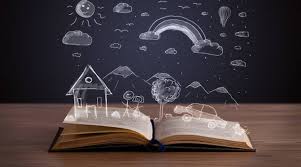A story told well can move the world. Well, telling it well enough, is easier said than done. Read on to find how young minds have explored varied strains of the enigmatic art of story telling.
Telling a story
Storytelling: history and impact
The art of storytelling is the ability to show a narrative that captivates and engages the audience . It is an ancient tradition that dates back to the beginning of human history when early civilization passed on myths , legends and beliefs through oral story telling .Storytelling is a powerful tool that can be used to convey ideas , values ,emotions and experiences, synchronising the brains of the teller and the listener. A skilled storyteller will not only entertain the audience , but will also inspire , educate and motivate them .
It needs a competent storyteller to make a story impactful in full potential. Anecdotes running through family generations keep family traditions revolving. A professor’s lecture that weaves in a story is always more difficult to forget. Even a business presentation that blends a story makes it more impactful, helping connect better with customers. In the space of public governance, political leaders have emerged as potential storytellers; story being a tool to rule the ignorant masses.
What makes powerful storytelling
Impactful storytelling requires a powerful story, or content. It comprises vivid imagery, descriptive language , compelling characters , a clear plot and a strong message or a theme. When exposed with artfulness, the story exposes us to different perspectives, training our minds to see situations from a different angle and opening them to new ideas. It develops empathy in understanding the experiences and emotions of others, even though we may not have experienced it ourselves. It creates a sense of shared experience and community, enriching us in the process.
In fact, scientific research shows that reading or listening to a story makes our brain produce chemicals such as Cristol, Dopamine and Oxytocin. While Cristol helps formulate our memory, dopamine regulates our emotional response and Oxytocin deepens our relationship with our world.
How our brain responds to storytelling
There is a story-like structure in our brains called the Neural Story Net. This helps connect disconnected elements in the form of a story, using a make sense mandate. Thus we are actually hardwired to think in story terms. This impacts how we understand things, make sense of things and what we choose to remember and what we choose to forget. Primarily there are two strategies of the story teller that helps put this to action. His timely pauses, tone, hand gestures, eye contact and finally posture help in listener engagement. As he weaves the story with closely interconnected threads, the story sounds more relevant.A parallel belief stream is created, acting as a powerful influencer.
About the authors
The article has been contributed by the following students from Our Lady Queen of the Missions School, Park Circus, Kolkata: Rajita Sadhukhan, Sana Abbas, Sadia Asif and Wriddhima Mukherjee.

